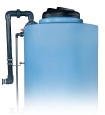Selecting the proper tank fitting—and location for the fitting—is an important matter. You need the right fitting for your application, and it’s not always easy to understand which one is the best choice for your needs.
Topics:
Installation and Field Service,
Fittings and Accessories
Steel tanks and vessels provide exceptional strength, but they’re susceptible to chemical corrosion. Any steel tank used for storing harmful chemicals will need to be protected with some form of internal lining/liner. A polyethylene lining system is designed to protect your steel tank against the harshest chemicals to give you broad chemical resistance alongside the durability and strength of a steel tank.
Topics:
Tank Design and Materials
Storing sulfuric acid is no cake walk. Sulfuric acid presents serious storage challenges that you need to be fully prepared to handle:
Topics:
Chemicals
How do you know by looking at a chemical storage tank how well it’s constructed? There’s a big difference between a well-designed, properly constructed tank and an inexpensive one that doesn’t meet structural requirements. But it takes more than the naked eye to spot critical flaws.
Topics:
Certifications and Standards
The pharmaceutical industry has a history of using stainless steel storage tanks due to the belief that the resins in a polyethylene storage tank would allow leaching and bacterial growth with pharmaceutical products. But stainless steel tanks have drawbacks. Because they can contain chemical attack points, the tanks require expensive coatings and ongoing maintenance and inspection. Seams and welding spots are especially prone to compromise.
Topics:
Applications
Aluminum sulfate, also known as cake alum or papermaker’s alum, is a flocculant chemical, much like ferric.
Topics:
Chemicals
Sulfuric acid is one of the most commonly used acids in the world and it is used in a wide variety of industrial applications. It’s commonly used in water and wastewater treatment and in the manufacturing of chemicals, fertilizers, and car batteries. It inherently releases high amounts of heat and presents unique storage challenges. Let’s look at the some of the storage challenges and best tank solutions.
Topics:
Chemicals
Sodium chlorite is an NSF/ANSI 61 approved chemical when using a high-density cross-linked polyethylene tank manufactured by Poly Processing. This salt-based chemical compound is an oxidizing agent that needs to be protected from contamination. If crossed accidentally with an organic material, sodium chlorite could produce an explosive reaction. With such a threat, it’s important that proper chemical storage be taken seriously.
Topics:
Chemicals
Safe chemical containment is not only the tank, its material, fittings, and accessories. Over time, chemical storage tanks become susceptible to cracks and leaks, and it is of the utmost importance to find any potential problems before they cause costly mishaps. This is why Poly Processing recommends an annual tank system inspection.
Topics:
Installation and Field Service
As winter approaches, you may often hear the important chemical Magnesium Chloride discussed. Magnesium Chloride is commonly used in different de-icing techniques across the northern parts of the country. But with so many people using it, it’s important that we discuss the proper storage solution.
Topics:
Chemicals



